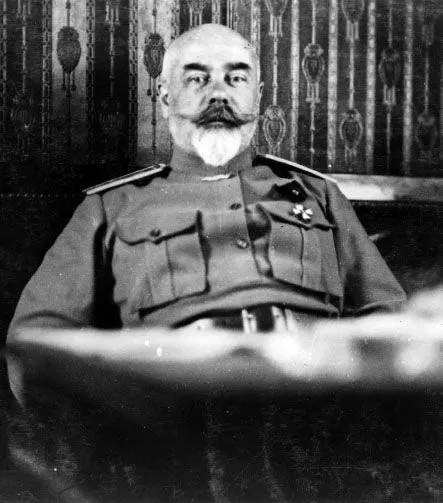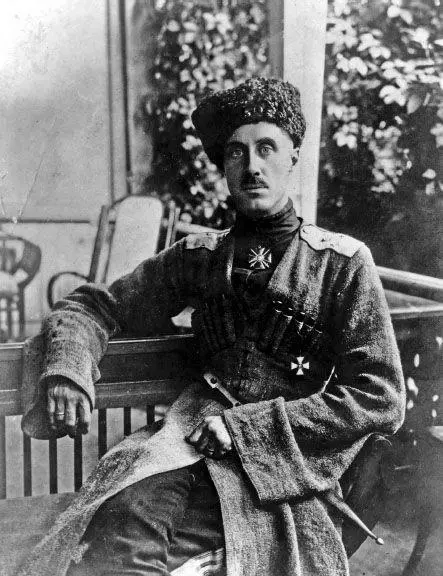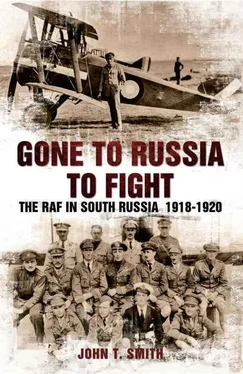THE MILITARY SITUATION IN SOUTH RUSSIA
The original justification for British intervention in south Russia was the Anglo-French Agreement of 23 December 1917. When it became obvious that Russia would soon be out of the war against Germany, an agreement was reached between Britain and France. Under this agreement, the Allies were planning to continue an Eastern Front against Germany on Russian territory, with or without the support of the Bolshevik government. France was given responsibility for the area west of the river Don, and Britain was given the Caucasus and the area north and east of the Caspian. In truth, while the First World War continued, there was little that could be done against the German occupation of the Ukraine or Turkey’s attempted occupation of the Caucasus. The Dunsterforce expedition had soon been driven out.
Earlier in 1917, the Kerensky government had asked the leader of the Army, General L. Kornilov, to move loyal Army units to St Petersburg to restore order. But as soon as Kornilov had started to move troops, Kerensky had lost his nerve and had him arrested for planning a military dictatorship. Kornilov was imprisoned, along with General Anton Denikin. They were held by military personnel, however, and were allowed to come and go as they pleased. The new head of the Army was General M. V. Alekseev. With the takeover of the Bolsheviks in the October 1917 Revolution (November in the new calendar), Alekseev fled to south Russia, thinking the Cossack regions in the south would be a centre of resistance to the Bolsheviks. In December 1917, he was joined by Generals Denikin and Kornilov, who had simply walked out of the prison in which they had been kept.
A small number of officers and men began to join Alekseev in the south to take part in the fight against the Bolsheviks. General Alekseev called this group the Volunteer Army. Most of the men joining Alekseev were officers, and some of the early units were made up entirely of officers. After some disagreement, General Kornilov became the military commander and Alekseev the political chief. The Cossack hosts were as war-weary as the rest of Russian society and failed to rise against the Bolsheviks. Also, the numbers joining the Volunteer Army remained small and the promised finance failed to arrive.

General Anton Denikin.
During February 1918, Rostov was captured by detachments of the Red Guard sent out from Moscow. At this early stage of the Civil War, many sections of the population supported the Soviet government, not having yet suffered under Bolshevik rule. With the fall of Rostov, Alekseev and Kornilov led the Volunteer Army, now 4,000-strong, into the north Caucasus. To the Volunteers, this period became known as the ‘Ice March’. During this time, massively superior numbers surrounded them on all sides as they marched across the frozen steppes. Kornilov, as the military commander, decided to attack Ekaterinodar, the Kuban Cossack capital, which was now the capital of the Kuban Soviet Republic, in order to give themselves a base for operations. The attack was started on 10 April 1918. During the fighting, Kornilov was killed by artillery fire when his command post in a farmhouse was hit. The command passed to General Denikin, who was forced to call off the attack on Ekaterinodar and retreat towards the Don territory.
Russia had been negotiating with Germany to end the fighting between them, but when these talks broke down during February 1918 the Germans again began to advance into Russia. What was left of the Russian Army melted away in front of the Germans. Large areas of eastern Europe were occupied, including the Ukraine. The Russians returned to the negotiations and signed the Brest-Litovsk peace on 3 March. As part of the settlement, the Germans were given a free hand in the Ukraine. On 8 May, they captured Rostov.
The Don Cossacks soon became tired of Soviet rule. In May 1918, a meeting of the Don Krug elected a new Ataman, General Peter Krasnov. The Red Guards only had a loose hold on the Don territory and were soon driven out. The region to the west of the territory held by the Don Cossacks was now occupied by the Germans, who supplied money and arms to the Cossacks. By the middle of June, the Don Cossacks had an Army of 40,000 operating against the Reds. The Red Army was still in its infancy and had few combat troops available to send to the south, forcing them to rely on local troops.
After they had reoccupied all their own territory, the Don Cossacks turned east to try to capture Tsaritsin. But, after months of fighting, they failed in their bid to take the city. Tsaritsin was a large, built-up industrial area with a substantial working-class population that had supported the Red takeover. Most of the Don Cossacks were cavalry, and they lacked the heavy forces needed to capture the trench lines around the city. In command in Tsaritsin during the summer of 1918 was Stalin, along with Vorishilov and Budenny in subordinate roles. Stalin clashed with Trotsky over the strategy in the south and over the use of ex-Tsarist officers in command positions and was finally recalled to Moscow.
The area around Tsaritsin.

General Baron Peter Wrangel.
The Volunteer Army was re-equipped with arms and munitions from Germany, acquired via the Don Cossacks. Volunteer Army policy had originally been to continue the war against Germany, but this does not seem to have stopped them taking German money and arms through the Cossacks. By June 1918, the Volunteer Army had grown to 9,000 and they again tried to capture the north Caucasus area from the Red government forces. On 18 August, they captured Ekaterinodar, the Kuban Cossack capital. Once they had been liberated, the Kuban Cossack leadership joined the Don Cossacks and the Volunteer Army in the fight against the Bolshevik forces.
The original Volunteer Army was an effective and disciplined force capable of defeating Red Army units of much larger numbers. General Denikin continued to advance eastward across the Caucasus, and the Red Army set up their new base at Piatigorsk on the main rail line to Tsaritsin. On 8 October 1918, General Alekseev died, leaving General Denikin as the undisputed leader of the Volunteer Army. The Don Cossacks were faced with the 8th and 9th Red Armies in the north and the 10th Army in Tsaritsin, but they continued to hold out against the increasing pressure. During August, General Peter Wrangel joined the Volunteer Army. Wrangel was forty years old and had been in the Army for seventeen years. He had risen to command a division in the First World War. When he arrived in Ekaterinodar, the Volunteer Army had grown in size to around 38,000 troops. Denikin, who knew Wrangel slightly, offered him command of a division in the Volunteer Army. Wrangel went on to become the most effective of the White generals.
The counter-revolution in the south was still a limited affair but the influx of huge amounts of Allied equipment, money, and men would transform the situation.
CHAPTER FOUR
DECEMBER 1918
The war with Turkey ended in October 1918 and the Armistice with Germany took effect on 11 November. This freed up access to the Black Sea. As part of the settlement, elements from the Allied forces occupied the fortifications along the Bosphorus. In late November, British ships from the Mediterranean fleet entered the Black Sea. This made the supplying of aid to the White forces in south Russia a practical proposition. Military supplies and men began to flow from bases around the eastern Mediterranean and Middle East into the quagmire of the Russian Civil War.
Читать дальше














